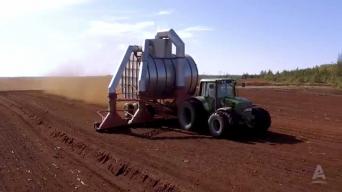
The Passionate Gardener: Peat Moss, a Gift from Our Neighbors to the North

Probably the best known and most important ingredient of soilless potting mixes, peat, or specifically, sphagnum peat moss, comes from bogs that originated 12,000 to 14,000 years ago. After the ice age, receding glaciers left depressions that collected water. Drowned plant material in these bogs only partly decomposed over the centuries, forming peat deposits. In Roman times, peat was used as fuel in homes. In countries where timber was scarce, such as Ireland and Scotland, it served as the local source of fuel. Today, in Finland, Russia, Ireland, Sweden and eastern Europe, peat is still used on an industrial scale to produce electricity.
Most peat in North America is from Canada, where peat bogs cover about 274 million acres, about 13% of the entire country, and are present in every province.
Sphagnum peat moss has been favored for many years for its ability to hold large amounts of air and water, making it an ideal component of propagation media. It’s a non-vascular (no roots) plant that thrives in a combination of an acidic, watery, low-nutrient environment and cool temperatures. Bacterial action is reduced in this type of environment which results in a rate of production of plants that exceeds the rate of decomposition. Over time, slowly decomposing vegetation debris accumulates and leads to the development of a peat deposit that could be as deep as 20 feet.
There are more than 335 species of sphagnum around the world, with about 16 of those found in Canada. Approximately five species are dominant with most bogs limited to only three species.
Throughout a peat bog, there are different degrees of decomposition depending upon the depth. In a cross-section of a peat bog, the surface is composed of recently accumulated peat moss that is blond in color and fibrous in texture; the lower sections of the bog contain peat that is more decomposed, dark brown in color and less fibrous.
Raw sphagnum peat is graded by its level of decomposition and humification. This “Von Post” scale, based on the color of the peat moss, the fiber content and the color of water squeezed from a sample, ranges from H1, not decomposed at all, to H10.
H1 grade raw peat is completely undecomposed peat which when squeezed releases almost clear water. Plant remains are easily identifiable. Going deeper, H4 sphagnum peat moss is more decomposed and when squeezed releases very muddy dark water. Plant remains are slightly pasty and have lost some of their identifiable features. H10 is completely decomposed peat with no discernible plant structure.
In North America, most sphagnum peat harvested is in the range of H1 to H5, with different grades typically blended to achieve specific physical properties. H1 peat moss is very fibrous so when used alone as a growing medium it shrinks in the container. H5 is good as a soil conditioner but it is normally blended since by itself it is too heavy.
When the sphagnum peat moss is combined with the proper ratio of aggregates, lime, vermiculite, perlite or other ingredients it makes a perfect media for seed starting, rooting of cuttings and seedling development.
Since 1991, the Canadian sphagnum peat moss industry has funded research with the Laval University in Quebec to study peat bogs and develop ways to restore peat lands. All producers are in agreement that restoration is essential to maintain the available peat moss for future generations and all practice approved and recommended restoration procedures by law.
For questions or comments: ron@primexgardencenter.com.
